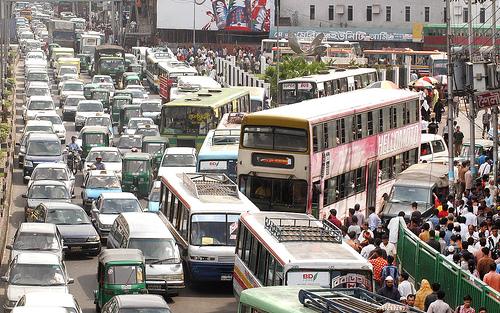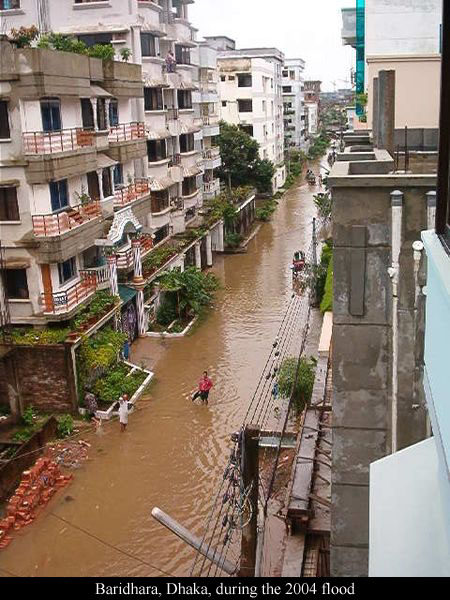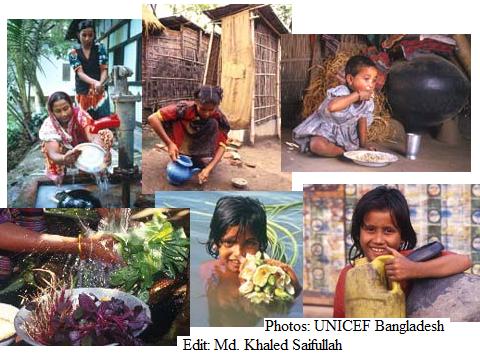Water Crisis of Dhaka, Bangladesh

Photo: Priyo
Water scarcity in the capital city Dhaka has worsened in the past few weeks due to frequent load shedding and fall in groundwater level. The people of Lalbagh, Kamalbagh, Islambagh, Nawabpur, Khilgaon, Mirpur, Hajaribagh, some parts of Mirpur and Mohammadpur, all part of Badda, Shewrapara, Kazipara, Paikpara, Kalabagan, Nayapaltan, Khilgaon, some parts of Moghbazar and Basabo alleged that they were acutely facing water crisis in the areas for the last couple of weeks. Recently Gulshan, Dhanmondi, Badda, Rampura and Bonhasri are facing water crisis.
Dhaka Water Supply and Sewerage Authority (WASA) said they are producing 160 to 165 crore liters of water a day against a demand of 205 liters, WASA officials said, which is about 25 percent less than demand. Managing Director of WASA Raihanul Abedin, said: “We hope to solve the water problem in the next four years as some WASA projects including setting up a water treatment plant and replacing old pipelines will take some time.” On emergency basis, the WASA is supplying water by tank lorries in different areas including Kajipara, Dhanmondi, Nakhalpara, Rampura, Badda, Shahjadpur, Basabo, Mohammadpur, Monipuripara, Rajabazar, Gulshan, Uttara, Mohakhali and others parts of Dhaka Metropolitan Area. But people claimed “to get water from WASA lorry, we usually have to wait for 10 days.” (more…)
Load Shedding of Electricity in Bangladesh

Photo: The New Nation
Bangladesh is facing huge load shedding of electricity. Almost all part of Dhaka having load shedding of electricity everyday at least four to five hours eveyday. In Karwan Bazar, power disruption occurred five times with more than five hours of outage between 8:00am and 5:00pm and in 24 hours almost eight to nine hours. Multiple power cuts for periods totaling six to seven hours occurred in Eskaton Garden, Dhanmondi, Kalabagan, Moghbazar, Khilgaon, Goran, Shahjahanpur, Mohammadpur, Banani, Uttara and other places.
Every summer Bangladesh face huge load shedding problem. According to the official statistics, the country’s electricity shortage gone up 1000 megawatts (MW) to 1259 MW with the demand of 4806 MW on 2006. Authority said this year (2009) about 1400 MW to 1800 MW electricity shortage will face this year, which is almost twice more than last year and the country need about 5000 MW. So this summer we might face the problem that’s we have not face last ten years. In Bangladesh electricity power is not generate as much as our demand. So every summer we face huge load shedding and people are suffering, but in winter there is almost not load shedding. In summer temperatures goes up to around 40° Celsius. So in this situation if there is load-shedding of electricity people face uncertain condition. (more…)
Traffic Jam of Dhaka, Bangladesh

I live in Dhaka, only 20 minutes away from my university; but I get out from my house about 1 hour and 15 minutes before class will start. Because of terrible traffic jam, most of the time it takes about an hour to reach university. I remember a week, right after Eid-ul-Fitr Dhaka city was like half empty, at that week I went to university in 20 minutes.
Dhaka is a mega city. More than twelve million people live here. Day by day the number is increasing and most part of Dhaka is badly affected by the population growth. More than 7 hundred thousand rickshaws ply the city road, but only 75 thousand have legal number. This huge number of rickshaws is creating traffic jam. From time to time attempts are made to reduce the number, but the initiative usually produces no results. The number of rickshaw pullers is huge. Almost there are no roads or street or lane free from traffic jam. (more…)
Causes of Flooding in Bangladesh

Photo: CGZ
Bangladesh is one of the world most densely populated country and one of the most susceptible countries to flood disasters. It also has one of the three most powerful rivers passing though it Ganges, Meghna and Brahmaputra. About one half of the land area in Bangladesh is at an elevation of less than 8 meters above sea level. Up to 30% of the country has been covered with flood waters. In 1991 more 200,000 deaths resulted from flooding and associated tropical cyclones. (more…)
Floods In Bangladesh

Photo: Raiyan Kamai
Baridhara is a zone designated for diplomats, high ranking civil and military officials, and politicians in Dhaka, Bangladesh. Most embassies are located in Baridhara and people works in embassies (foreigners) lives here. It is an affluent part of Bangladesh which is evident by local infrastructures. It is also the location of the American International School of Dhaka (most expensive school in Bangladesh).
Bangladesh, which has 156 million people (July 2009 est.) and the area is 144,000 sq km including 10,090 sq km of water, so the total land is 133,910 sq km. Bangladesh is one of the most vulnerable places to climate change. As the sea level slowly rises, this nation that is little more than a series of low-lying delta islands amid some of Asia’s mightiest rivers – the Ganges, Jamuna-Brahmaputra and Meghna. Bangladesh has more than 150 rivers cross Bangladesh and almost all rivers flows close to the danger marks during flood time. Experts said that major rivers like Jamuna and Padma could overflow at anytime if heavy rainfall occurs and continues for a week. (more…)
Street People of Dhaka

Picture: Dhaka Courier
“Jamir shar is a youngster whose age is close to thirteen. This parentless lad came to Dhaka city three years ago. He lost his parents in a road accident. With nobody to take care of him, he sells nuts in different areas of Dhaka city. He lives with a family at Pirjangi Mazar in Motijheel, taking his two meals with them and giving them his total income, which ranges from Taka 50 to 60.” (Dhaka Courier)
“Anwar Ali sells tea, biscuits and cigarettes in the city’s parks. He came to Dhaka from Mymensingh (a district in Bangladesh) five years ago. His two sons live in Mymensingh with their mother. Sometimes Anwar Ali goes to his village. He lives near Khilgaon Rail Gate and starts his work at dawn returning late to his house made out of waste plastic.” (Dhaka Courier) (more…)
Environment, Sanitation and Water in Bangladesh

Human development and safety depends on having access to clean water, knowledge about hygiene and sanitary environment. According to the government, Bangladesh has already achieved a safe water supply and sanitary facilities for 80 percent of the population and improved the hygiene practices of 60 percent of the population by the help of UNICEF. While a multiple indicator cluster survey conducted in 2006 revealed that 39 percent of people had access to improved sanitation facilities. “Government figures are giving reasonable estimates of households that have a toilet of some description, but not necessarily conforming to the accepted slab and ring latrine which is a standard of improved sanitation,” Paul Edwards of UNICEF said. (more…)
The Arctic Ice Cap
The Arctic ice cap shrank so much that waves briefly lapped along two long-imagined Arctic shipping routes, the Northwest Passage over Canada and the Northern Sea Route over Russia. Complicating the picture, the striking Arctic change was as much a result of ice moving as melting.


A host of Arctic scientists say it is too soon to know if the global greenhouse effect has already tipped the system to a condition in which sea ice in summers will be routinely limited to a few clotted passageways in northern Canada.


As we move along with those pictures we can see the Arctic ice caps are melting but very fast. In 2005 the scenario was much worst.

All those pictures were taken on September 16th each year, which is right after the summer. Summer 2007 shows a record breaking loss of arctic sea ice. Experts attribute the changes to the interaction of wid. Weather, ice drift, ocean current and greenhouse gases. (more…)
Global Warming
Global Warming is an environmental issue that is continuing to harm our planet. The definition of Global Warming is “the increase in the average temperature of the Earth’s near-surface air and oceans since the mid-20th century and its projected continuation” (Wikipedia). Therefore, if in the winter snow melts faster than it snows then there has to be something wrong with Earth because average temperature for many years that change one year? The answer is Global Warming. All of sudden icebergs started to melt in Antarctica, North Pole, Greenland and Alaska because of Global Warming. “If we could see with our own eyes how fast the icebergs are malting and hear the sound cracking and crashing of icebergs one into another, we would realize better, what we are doing to our own planet” (An inconvenient truth).
“It is now clear that we face a deepening global climate crisis that requires us to act boldly, quickly and wisely” said Al Gore.
8 comments